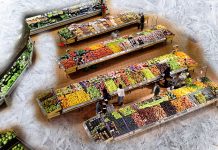
The cold chain is one of the systems with the highest energy intensity in the food and drink sector. It consists of a series of stages – refrigerated transport, processing, storage and sale – with a high energy consumption. The implementation of ameliorative measures very often concerns single companies but, carrying out transversal provisions to the various steps, it would allow exploiting unexplored potentialities. This is precisely the issue of the European Project ICCEE – Improving Cold Chain Energy Efficiency – recently accomplished and coordinated by the University of Brescia with the research team of Simone Zanoni, professor of Industrial Systems Engineering.
Innovative contributions
«Shifting from the single company’s prospect to the assessment of the energy consumptions of the chain in its whole: this is the great novelty of ICCEE project» states Zanoni. Novelty, because nowadays an instrument that permits to analyse the chain in its whole does not exist on the market. «Along the chain, there are very often virtuous companies that perform what is possible for them to improve their energy consumptions. However, the interdependences in the chain sometimes risk of partially annulling such efforts owing to the lack of coordination». Becoming aware of these interdependences is fundamental to understand that the best results are not always achieved by optimizing a site and leaving the others intact.
However, that is not all: «In the numerous analyses that we have carried out along different cold food chains – examined individually according to the product typology – we have noticed that measures of efficiency enhancement in different chain links lead to a different amplification of the result. In other words, there are items where the investments in efficiency measures are significantly more efficient from the point of view of the cost/benefit ratio. One of the project’s targets was highlighting in each chain the items where the introduction of efficiency enhancement provisions could exert the maximum impact. The fact of assessing various players along the chain points out what players can give the highest contribution and therefore on which of them it is worth focusing for possible efficiency amelioration efforts».
Finally, we should not underestimate the influence of a well-organized chain on the food quality: «Even in frozen or refrigerated foods a degradation of products’ organoleptic qualities takes place, although naturally slower than what happens at environmental temperature. A well-organized cold chain permits to handle and to conserve goods in the best possible way» Zanoni ends.
In the project context, chain analyses for different products have been carried out. What are the points where much efficiency enhancement potential still exists? «While, in general, the managers of warehouses and refrigerating cells are highly sensitive to the energy matter and many of them have carried out measures of energy efficiency improvement, for instance by installing more efficient refrigeration plants, there is still a lot of improvement potential in transports and in the management of stocked up goods, especially in terms of space subdivision into compartments and in general for the management of transport and warehouse saturation» Zanoni states.
ICCEE toolbox
ICCEE has integrated cold chains’ characteristics of the food and drink sector in an analytical support tool to the decisions with customized analyses concerning the energy performances for the various process phases (for instance, processing of raw materials, logistic and storage operations, product manufacturing and processing, packaging). This “toolbox” is an instrument that provides the players involved in the cold chain with important advantages for the assessment of the consumption of each energy carrier for refrigeration through the storage and transport activities along the cold chain. It consists of seven tools that can be partly used at the single site level and partly at chain level. The use of the vast majority of these tools does not need the typical knowledge as energy manager whereas some are instead thought for energy professionals and with them it is possible to carry out chain-level analyses. It aims at being not only a measurement instrument of energy consumptions but it also takes into account environmental parameters like the water consumption and the greenhouse emissions of some chain steps. Finally, the tool aims at creating awareness among all those who operate on the chain because environmental and managerial, not only technological, aspects, play an important role in the energy efficiency.
The analysis tool described in this text and developed by the project is available on the https://iccee.eu/ page for all interested people.



